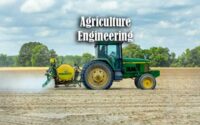Agriculture Engineering GK Objective Question Papers
1. Maximum size of raindrop varies from
(a) 0.5mm-7.0mm
(b) 0.5mm-6.0mm
(c) 0.6mm-7.0mm
(d) 0.5mm-8.0mm
2. Precipitation caused by natural rising of warmer lighter air in colder, denser surrounding is called
(a) Orographic precipitation
(b) Convective precipitation
(c) Frontal precipitation
(d) Both (a) & (c)
3. Precipitation is said to be drizzle when the water droplets and its intensity is
(a) <0.5mm & <0.01 mm/hr respectively
(b) >0.5mm & >0.01mm/hr respectively
(c) <0.5mm & >0.01mm/hr respectively
(d) <0.05mm & <0.1 mm/hr respectively
4. Graph showing plot of cumulative depth of rainfall against time is
(a) Hyetograph
(b) Mass curve
(c) Hydrograph
(d) S-Curve
5. For a slope % of 15-35, the land use classification can be characterized as
(a) Class III
(b) Class IV
(c) Class V
(d) Class VI
6. Calculate the volume of earthwork involved in contour bunding for a 100ha catchment area having a land slope of 3%, if the parameters for contour bund are to be VI=1.5m; base width=2.25m; top width=0.50m; height of bund=1.0m. Assume 30% lateral and side bunds of the main bunding.
(a) 35750 m3
(b) 35000 m3
(c) 35570 m3
(d) 35770 m3
7. A drop spillway is subjected to horizontal and vertical forces of 40.8kN and 36.5kN respectively. The area of plane if sliding is 10m2. Angle of internal friction and cohesive resistance of foundation material are 25o and 4.9kPa respectively. The factor of safety against sliding is
(a) 0.53
(b) 0.61
(c) 1.62
(d) 1.86
8. A 24hr 10 year recurrence interval storm results in 0.5m depth of water behind the contour bund constructed on loamy sand soil having slope of 2%. The base width of the bund is
(a) 3.75m
(b) 3.25m
(c) 3.50m
(d) 3.00m
9. Chute spillway is used in control a drop of
(a) 0-3m
(b) 1-4m
(c) 2-4m
(d) 3-6m
10. For a large discharge capacity, a chute spillway inlet should be
(a) Rounded rectangular box type inlet
(b) Flat rectangular inlet
(c) Straight inlet
(d) Concave shaped rectangular inlet
11. Drop structures are used to control
(a) V-shaped gullies
(b) U-shaped gullies
(c) Ravine
(d) Both (a) & (b)
12. In EI30, I30 stands for
(a) Rainfall intensity as 30cm
(b) Max. Rainfall intensity for 30cm duration
(c) Rainfall intensity at 30min interval
(d) None of these
13. A straight drop structure consists of
(a) Inlet and outlet
(b) Apron, weir and conduit
(c) Inlet, conduit and outlet
(d) Earth dam and outlet
14. Location of permanent gully control structure is decided on the basis of
(a) Gully depth
(b) Gully width
(c) Gully bed slope
(d) All of these
15. Purpose of Cut of Wall in drop structure is to
(a) Provide structure strength against sliding
(b) Spill the flow safely
(c) Dissipate K.E.
(d) Support gully walls
16. Hydraulic jump takes place when the flow enters from
(a) Critical state to super critical state
(b) Super critical to sub critical state
(c) Subcritical state to super critical state
(d) Uniform flow to non-uniform flow
17. General form of relationship between EI30 and rainfall depth is
(a) EI30 = aPb
(b) EI30 = 1exp(P)
(c) EI30 = a + b log P
(d) EI30 = a + bP
18. A chute spillway with box type inlet consists of
(a) SAF stilling basin
(b) Ogee type inlet
(c) Apron
(d) None of these
19. Drop inlet spillway also performs the function of
(a) Farm pond
(b) Reservoir
(c) Irrigation structure
(d) Both (a) & (b)
20. To obtain cement dry powder, lime stone and shales or their slurry, is burnt in a rotary kiln at a temperature between
(a) 1100° and 1200°
(b) 1300° and 1400°
(c) 1200° and 1300°
(d) 1400° and 1500°
More Questions on Agriculture Engineering
21. The maximum percentage of chemical ingredient of cement is
(a) Magnesium oxide
(b) Aluminum
(c) Iron oxide
(d) Lime
22. The minimum percentage of chemical ingredient of cement is that of
(a) Magnesium oxide
(b) Iron oxide
(c) Silica
(d) Alumina
23. The high strength of rapid hardening cement at early stage, is due to its
(a) Finer grinding
(b) Burning at high temperature
(c) Increased lime cement
(d) High content of tricalcium
24. Water cement ratio is generally expressed in volume of water required per
(a) 10kg
(b) 20kg
(c) 30kg
(d) 50kg
25. Addition pozzolana to ordinary port land cement causes
(a) Decrease in early strength
(b) Reduction in chemical action with sulphates
(c) Increase in shrinkage
(d) All of these
26. Setting time of cement increases by addition of
(a) Gypsum
(b) Calcium chloride
(c) Sodium oxide
(d) Calcium sulphate
27. Workability of cement is measured by
(a) Vicat apparatus test
(b) Slump test
(c) Minimum void method
(d) Talbot Richard test
28. The mixture of different ingredients of cement is burnt at
(a) 1000°C
(b) 1200°C
(c) 1400°C
(d) 1600°C
29. For construction of structure in sea water, the cement generally preferred to, is
(a) Portland-pozzolana cement
(b) Quick setting cement
(c) Low heat Portland cement
(d) Rapid hardening cement
30. The difference between a shallow tube-well is on the basis of
(a) Depth of tubewell
(b) Position of water table & pump
(c) Aquifer type
(d) Aquifer depth
31. For a constant discharge if the diameter of a pipe is reduced to half, other factors remaining unchanged, the frictional head loss will increase by
(a) 4 times
(b) 8 times
(c) 16 times
(d) 32 times
32. The brake horse power of a centrifugal pump varies directly
(a) As speed of impeller
(b) As cube speed of impeller
(c) As square speed of impeller
(d) As forth power the speed of impeller
33. Safe entrance velocity through a well screen is
(a) 0.3mm/s
(b) 3.0mm/s
(c) 30mm/s
(d) 300mm/s
34. Cavity well with blind pipe
(a) Do not have strainers & water enters from bottom.
(b) Do not have strainers & water enters from sides.
(c) Have strainers & water enters from bottom.
(d) Have strainers & water enters from bottom and sides
35. Keeping other factors constant, doubling the diameter of a tubewell will increase the discharge by
(a) 10%
(b) 25%
(c) 50%
(d) 100%
36. If the impeller speed of a centrifugal pump is doubled, the power consumption will be
(a) The same
(b) Doubled
(c) Four times
(d) Eight times
37. The available net positive suction head of a pump depends on
(a) The suction lift
(b) Friction loss
(c) Vapour pressure
(d) All of these
38. The well in which the water level remains at the water table level is
(a) Non-artesian wells
(b) Flowing artesian wells
(c) Non- flowing artesian wells
(d) Confined wells
39. A centrifugal pump running at 1450 rpm discharges 20ltrs/s at 30m total head. The specific speed of the pump will be
(a) 12
(b) 16
(c) 20
(d) 24
40. In a centrifugal pump, if the speed is increased from 1750 rpm to 2000rpm, the head will change from 50m to
(a) 38.3m
(b) 65.3m
(c) 56.3m
(d) 100m
41. A centrifugal pump has a cavitation coefficient of 0.3. For a total head of 50m the net positive suction head at the critical point will be
(a) 12m
(b) 10m
(c) 15m
(d) 166.7m
42. A cavity well is most suitable under the following conditions
(a) Aquifer with fine sand & small thickness
(b) Aquifer with coarse sand & small thickness
(c) Aquifer with coarse sand & large thickness
(d) Aquifer with coarse sand & hard covering layer
43. A centrifugal pump at its best point of efficiency discharge 0.03m3 of water per second against a total head of 40m when the speed is 1450 rpm. Then the specific speed of the pump is
(a) 15.00rpm
(b) 15.77rpm
(c) 14.00rpm
(d) 14.77rpm
44. Suction lift exists in a centrifugal pump when the
(a) Source of water supply is at the centre line of the pump
(b) Source of water supply is below the centre line of pump
(c) Source of water supply is above the centre line of pump
(d) None of these
45. In which surveying, the curvature of the earth is not taken into account, as the surveys only extends over the small scale surveying
(a) Theodolite surveying
(b) Geological surveying
(c) Marine surveying
(d) Plane table surveying
46. Perambulator is used to measure the
(a) Distance
(b) Speed
(c) Pressure
(d) Weight
47. The length of Gunter’s chain is
(a) 33ft
(b) 200ft
(c) 66ft
(d) 20ft
48. The length of each link in engineering chain is
(a) 0.66ft
(b) 1ft
(c) 0.33ft
(d) 0.2ft
49. The horizontal angle between the true meridian and a line is called
(a) True bearing
(b) Magnetic bearing
(c) Arbitrary bearing
(d) Angle
50. The bearing of line in the direction of the progress of survey is called
(a) Back bearing
(b) Back ware bearing
(c) Fore bearing
(d) Line bearing
51. Method of surveying in which the fieldwork and plotting are done simultaneously is called
(a) Compass surveying
(b) Plane table surveying
(c) Mapping
(d) Drawing
52. Fixed reference point of known elevation is called as
(a) Bench mark
(b) Change point
(c) Turning point
(d) Reduce level
53. The contour interval on a map is 15m. if the upward gradient of 1 in 20 is required to be drawn between two points. The horizontal equivalent between A and B will be
(a) 240m
(b) 300m
(c) 450m
(d) 15m
54. Give the designation to the scale 1/1000
(a) 1cm = 10m
(b) 1cm = 100mm
(c) 1cm = 100m
(d) 1cm = 100cm
55. A cylinder bar of 40mm diameter and 1m length is subjected to a tensile test. Its longitudinal strain is 6 times that of its lateral strain. If the modulus of elasticity is 2 x 105 N/mm2, then its modulus of rigidity will be
(a) 0.86 x 102 N/mm2
(b) 8.60 x 102 N/mm2
(c) 0.86 x 105 N/mm2
(d) 8.60 x 105 N/mm2
56. A cantilever beam of length 4m having cross-sectional dimensions as 50mm x 150mm is failed by applying a force of 15kN at the free end. The bending stress at the failure is given by
(a) 480N/mm2
(b) 320N/mm2
(c) 160N/mm2
(d) Zero
57. Good brick clay should contain an Alumina percentage of about
(a) 10-20
(b) 20-30
(c) 30-40
(d) 50-60
58. Silica contain in brick clay should be at the range of
(a) 10-20 %
(b) 40-50 %
(c) 30-40 %
(d) 50-60 %
59. Percentage shrinkage allowance provided on moulds for brick manufacture is
(a) 2-6%
(b) 8-12%
(c) 32-24%
(d) 8-14 %
60. A steel rod of circular section tapers from 2cm diameter to 1cm diameter over a length of 50cm. If the modulus of elasticity of the material is 2 × 106 kg/cm2, then the increase in length under a pull of 300 kg will be
(a) 0.3/(2π)cm
(b) 30/(2π )cm
(c) 300/cm
(d) 750cm
61. The state of two-dimensional stresses acting on a concrete lamina consists of a direct tensile stress 1.5N/mm2 and shear stress 1.20N/mm2, which cause cracking of concrete. Then, the tensile strength of the concrete in N/mm2 is
(a) 1.50
(b) 2.08
(c) 2.17
(d) 2.29
62. A timber beam rectangular section is simply supported at the ends and carries a concentrated load at mid span. The maximum longitudinal stress is 16N/mm2 and the maximum shear stress is 2.5N/mm2. The ratio of span to depth would be
(a) 10
(b) 4
(c) 6
(d) 3.2


